Data on births, deaths and marriages presented in this release were obtained from the Certificate of Live Birth (Municipal Form 102), Certificate of Death (Municipal Form 103) and Certificate of Marriage (Municipal Form No. 97) that were registered at the Office of the City/Municipal Civil Registrars and forwarded to the Philippine Statistics Authority - Provincial Statistical Offices in Ilocos Region. Information included births, deaths and marriages registered in January to March 2018 and January to March 2019.
Birth Statistics
The number of registered live births in Ilocos Region during the first quarter of 2019 summed up to 22,973, an increase of 5.3 percent compared to 21,813 registered births at the same period of 2018. The daily average birth occurrence during the first quarter of 2019 was computed at 255 births or an average of about 11 babies born per hour. Consistently, the month of January was observed to have the highest average daily births at 272 and 293 babies during the first quarter of 2018 and 2019, respectively.
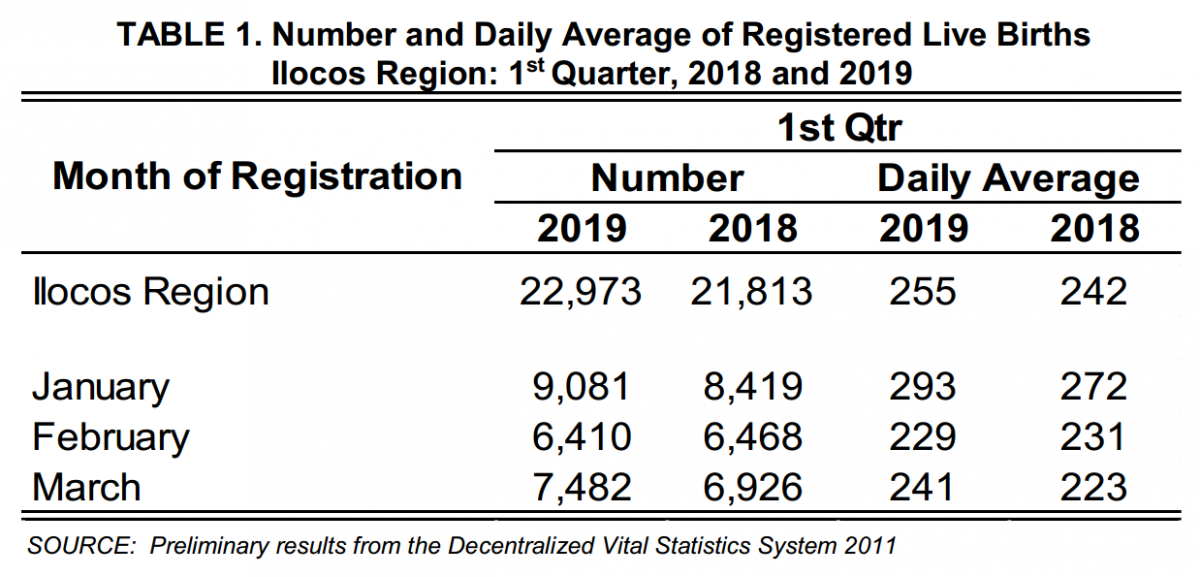
The highest number of registered live births during the first quarter of 2018 and 2019 was recorded in the month of January. The percent share of the total births in January to the quarterly totals were 38.6 percent in 2018 and 39.5 percent in 2019.
The month of February was observed to have the least number of registered live births at 6,468 and 6,410 during the first quarter of 2018 and 2019, respectively.


Among the provinces in the region, the province of Pangasinan registered the highest number of births in the first quarter of 2019. Its share was more than half (64.2 percent share) of the total registered births in Ilocos Region. The province of La Union ranked second with 3,361 births (14.6 percent share), followed by the province of Ilocos Sur with 2,983 births (13.0 percent share) and the province of Ilocos Norte with 1,875 (8.2 percent share).

In first quarter of 2019, Dagupan City, Pangasinan ranked first among the top ten Cities/Municipalities in Ilocos Region that registered the highest number of live births with 2,815. This was followed by San Carlos City,Pangasinan with 2,625 births; City of San Fernando, La Union with 1,741 births; City of Urdaneta, Pangasinan with 1,526 births; and City of Alaminos, Pangasinan with 1,138 births.
On the other hand, the municipalities of Dumalneg, Ilocos Norte, Gregorio Del Pilar and Sigay, Ilocos Sur, had the lowest number of registered live births in first quarter of 2019 with two registered births each. It was followed by Carasi, Ilocos Norte with three registered live births and Banayoyo, Ilocos Sur and Burgos, Ilocos Norte with four registered births each.

Males (11,657) outnumbered females (11,316) in terms of registered live births during the first quarter of 2019, resulting to a sex ratio of 103 males per 100 females.
Pangasinan posted a sex ratio of 104 which is higher than the regional ratio. The sex ratio of 103 males per 100 females was recorded in La Union followed by Ilocos Sur with 102. On the other hand, Ilocos Norte posted the lowest sex ratio in the region with 95.
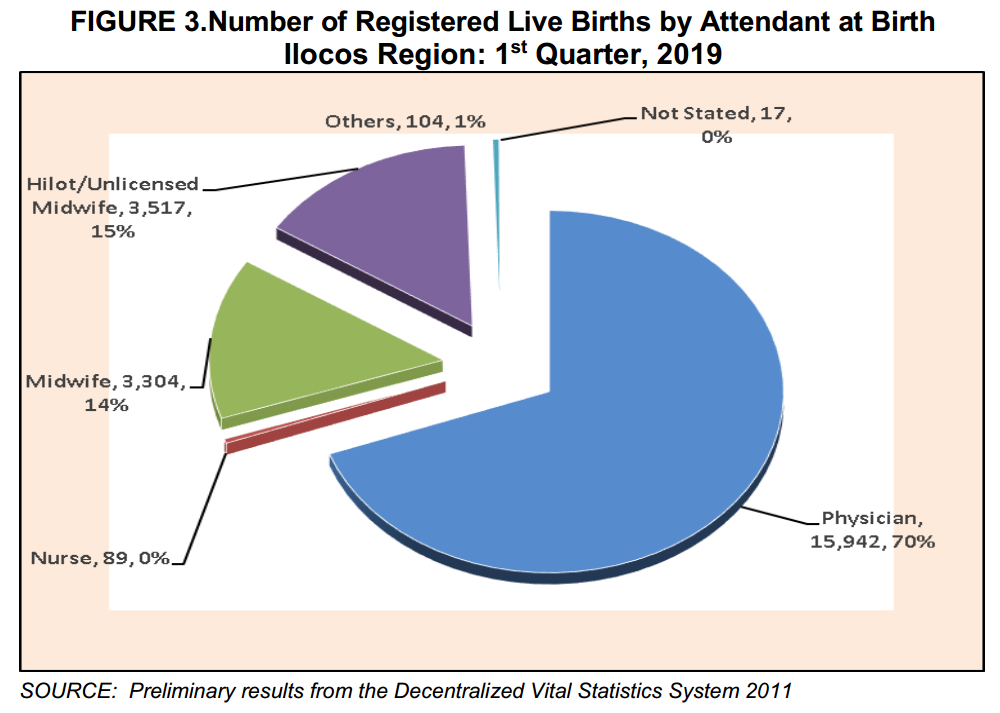
In first quarter of 2019, there were 84.2 percent or 19,335 of total registered live births were attended by medical practitioners who may either be a physician, a nurse or a midwife. The province of La Union had the highest percentage of birth deliveries tended by health professionals with 88.4 percent of the total registered live births in the province followed by Pangasinan with 85.7 percent, Ilocos Norte with 78.8 percent and Ilocos Sur with 75.2 percent.
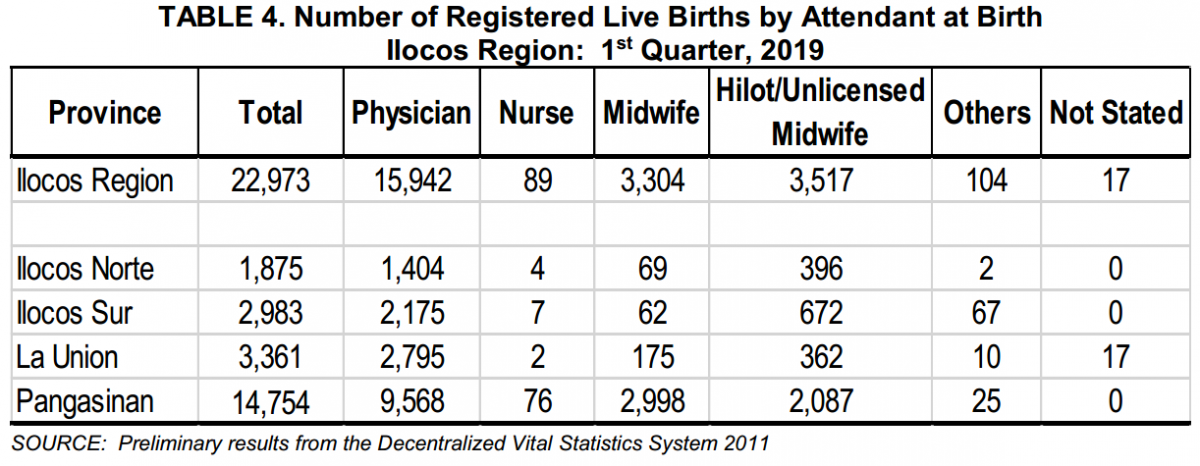
Marriage Statistics
There were 9,518 marriages registered during the first quarter of 2019, showing an increase of 10.1 percent from the figure on the same period last year of 8,648 marriages.
Three provinces recorded an increase in the number of registered marriages from first quarter of 2018 to first quarter of 2019. The biggest increase was noted in Ilocos Sur from 971 to 1,137 marriages (17.1 percent), followed by Pangasinan from 5,575 to 6,257 marriages (12.2 percent), while that of Ilocos Norte increased from 804 to 893 marriages (11.1 percent).
Only the province of La Union posted a decrease of 5.2 percent in the number of registered marriages in the region from 1,298 to 1,231 marriages.

The province of Pangasinan remained with the most number of registered marriages in the region in first quarter of 2019 with 6,257 marriages (65.7 percent share). La Union ranked second with 1,231 (12.9 percent share) followed by Ilocos Sur with 1,137 (11.9 percent share). In same period a year ago, La Union also ranked second with 1,298 marriages (15.0 percent share) while Ilocos Sur ranked third with 971 marriages (11.2 percent share).
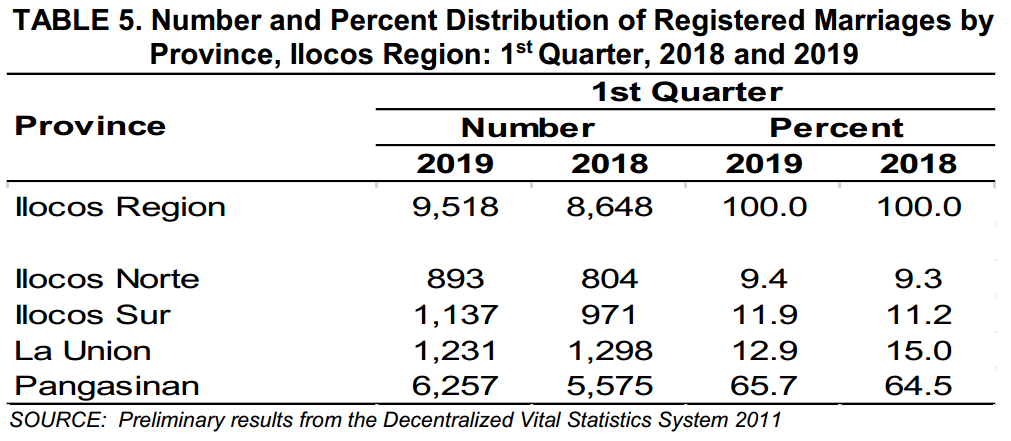
On the other end, the province of Ilocos Norte posted the least number of registered marriages during the first quarter of 2018 and 2019 with 804 (9.3 percent share) and 893 (9.4 percent share), respectively.

The month of January was the most preferred month to tie the knot during the first quarter of 2018 and 2019 with a total of 3,918 and 4,250 marriages, respectively. It corresponds to a daily average of 126 and 137 registered marriages, respectively which surpassed the regional daily average number during the first quarter of 2018 and 2019. On the other hand, March recorded the least number of marriage occurrences during the first quarter of 2018 and 2019 with a total of 2,083 and 2,182 marriages translating to a daily average of 67 and 70 registered marriages, respectively.
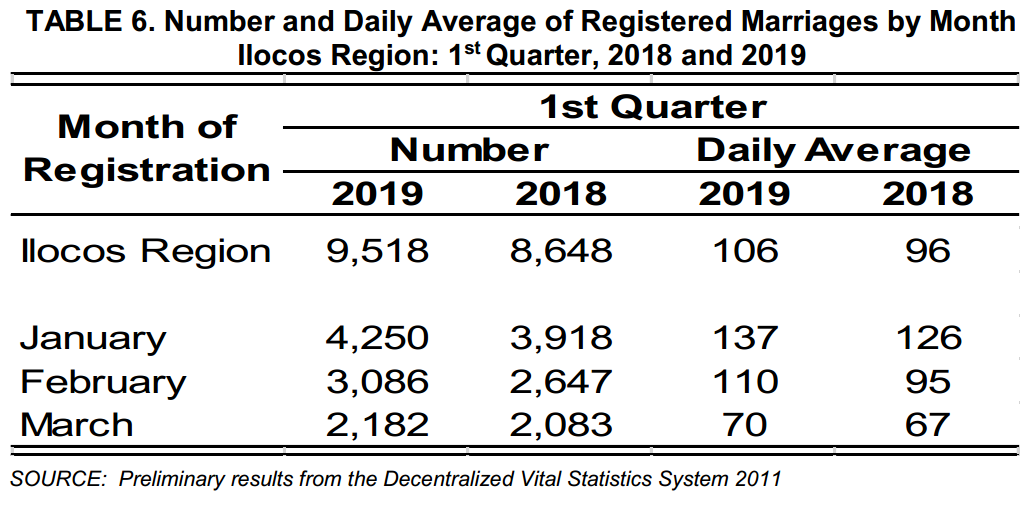
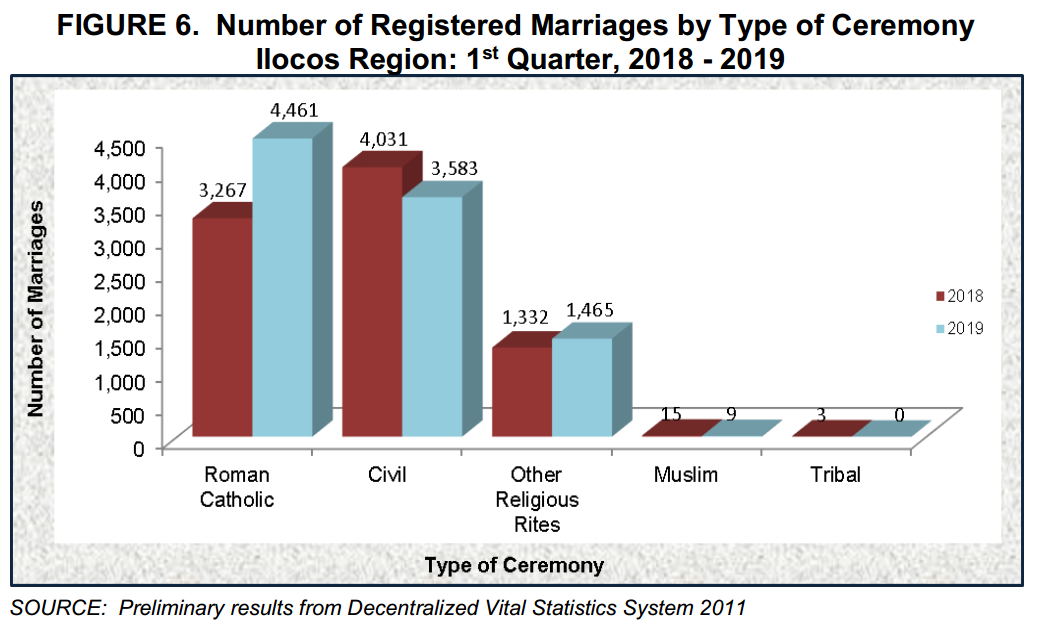
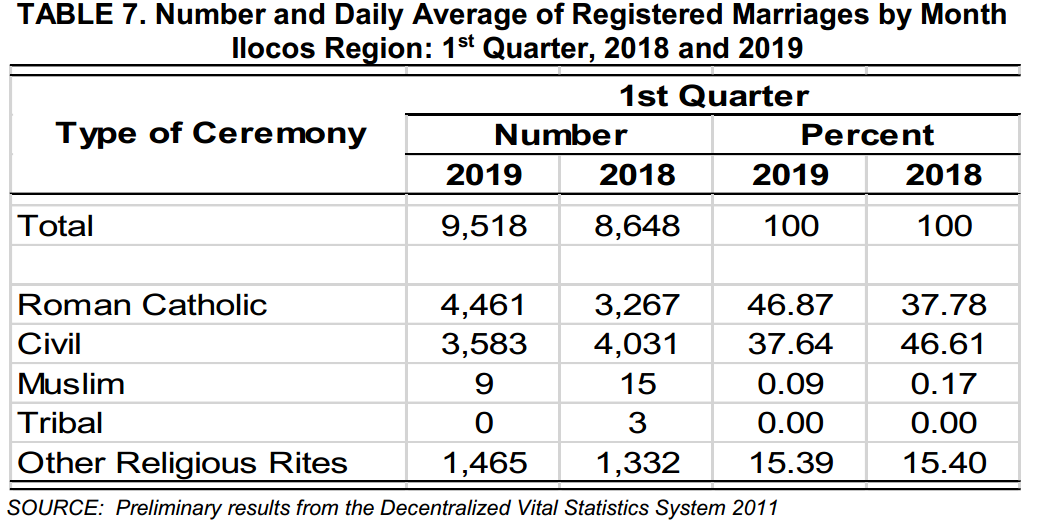
Marriages officiated in Roman Catholic Church topped the list among all types of marriage ceremonies in first quarter of 2019. It comprised 4,461 marriages or 46.87 percent of the total reported marriages. Marriages contracted through civil rites ranked second with 3,583 marriages or 37.64 percent share followed by other religious rites with 1,465 or 15.39 percent.
In same period last year, marriages contracted through civil rites registered the highest number of marriages with 4,031 marriages or 46.61 percent share, followed by Roman Catholic Church with 3,267 marriages or 37.78 percent share.
On the other end, marriages carried out under tribal rites posted the lowest number of registered marriages in first quarter 2018 with three marriages and no report of marriage in first quarter of 2019.
Death Statistics
A total of 9,378 deaths were registered during the first quarter of 2019. The figure indicated an increase of 9.8 percent death occurrences from the 2018 figure of 8,538.
The province of Pangasinan ranked first in terms of the number of registered deaths during the first quarter 2019, with a total of 5,523 or 58.9 percent share of the total registered deaths in the region. La Union placed second with 1,525 registered deaths (16.3 percent share), followed by Ilocos Sur with 1,228 (13.1 percent share) and Ilocos Norte with 1,102 (11.8 percent share).
In the same quarter of 2018, Pangasinan recorded 4,889 deaths or 57.3 percent of the total registered deaths in the region. Distantly followed by La Union with 1,360 (15.9 percent share), Ilocos Norte with 1,147 (13.4 percent share) and Ilocos Sur with 1,142 (13.4 percent share).
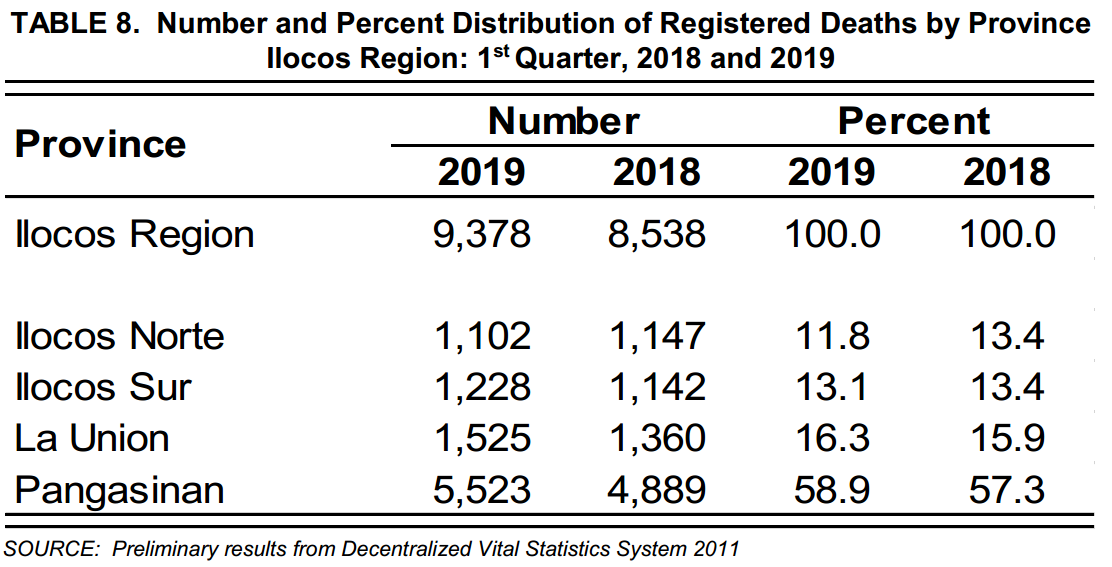
Comparing the two periods, Pangasinan posted the highest percent increase at 13.0 percent from 4,889 deaths in 2018 to 5,523 deaths in 2019. Followed by La Union with 12.1 percent and Ilocos Sur with 7.5 percent. On the other hand, only the province of Ilocos Norte reported a percent decrease at 3.9 percent from 1,147 deaths in first quarter of 2018 to 1,102 deaths in same period of 2019.
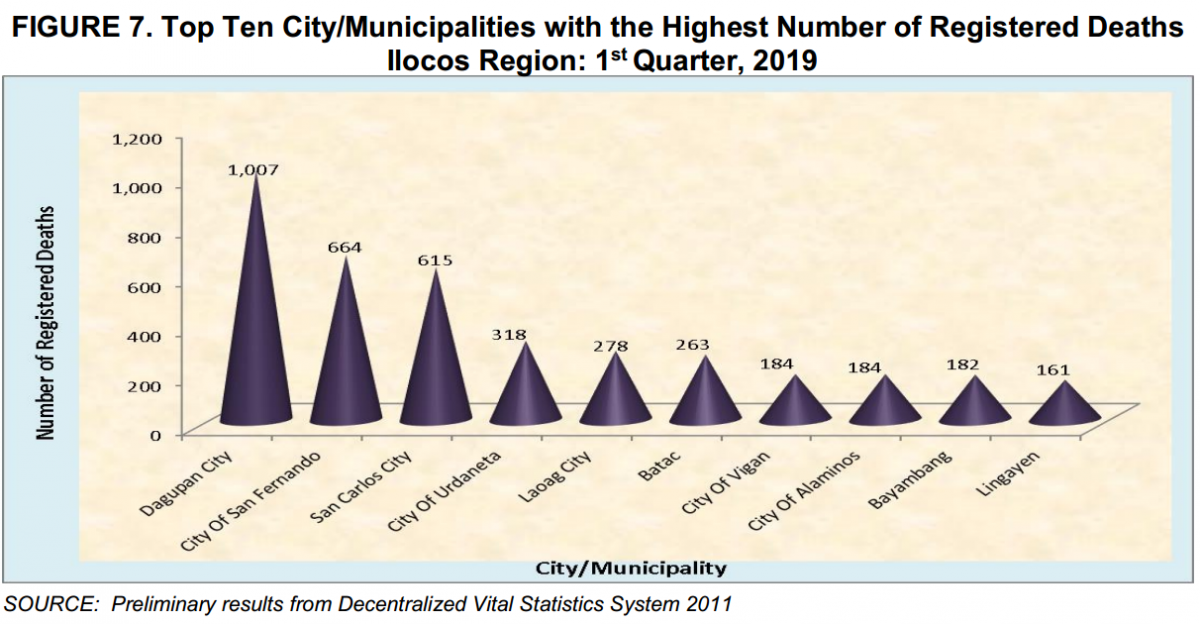
The cities of Dagupan, San Fernando, San Carlos, Urdaneta and Laoag posted the highest number of registered deaths in first quarter of 2019 with 1,007, 664, 615, 318 and 278 deaths, respectively. On the other hand, the municipalities of Carasi, Adams, Sigay, Dumalneg, Nagbukel and Gregorio Del Pilar had the least number in terms of the number of registered deaths: Carasi with one registered death; Adams with two deaths, Sigay with three deaths, Dumalneg with four deaths and Nagbukel and Gregorio Del Pilar with seven death occurrences each.
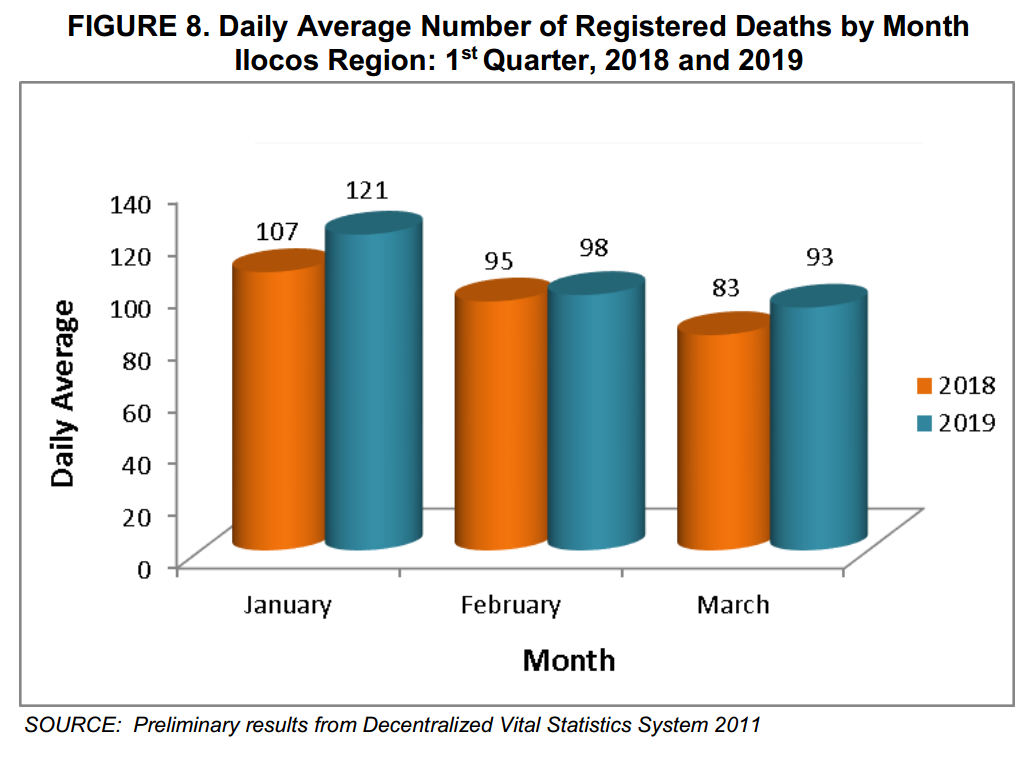
During the first quarter of 2019, mortality was at its peak in the month of January with total registered deaths of 3,752. This figure was more than one-third of the regional quarterly total of 9,378 death occurrences. The number of deaths in the month of January 2019 translates to an average of 121 death occurrences per day. The figure was higher than the daily average death occurrences in the region which is 104. February posted the lowest number of registered deaths with 2,741 in first quarter of 2019.
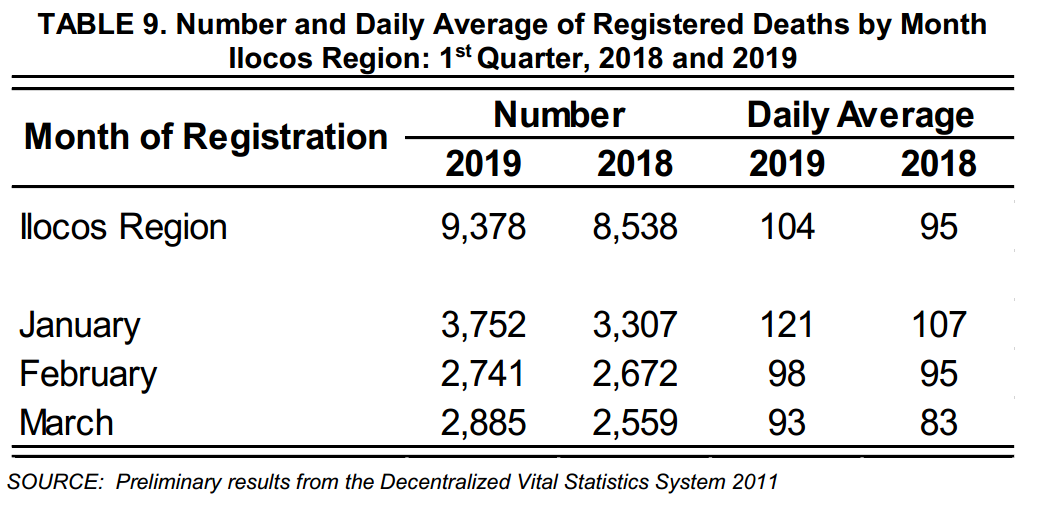
In the same period of 2018, the highest number of registered deaths was also in the month of January with 3,307 death occurrences, followed by the month of February with 2,672. The smallest number of registered deaths was in March with 2,559. January 2018 has the highest daily average of 107 death occurrences followed by February with a daily average of 95 death occurrences.
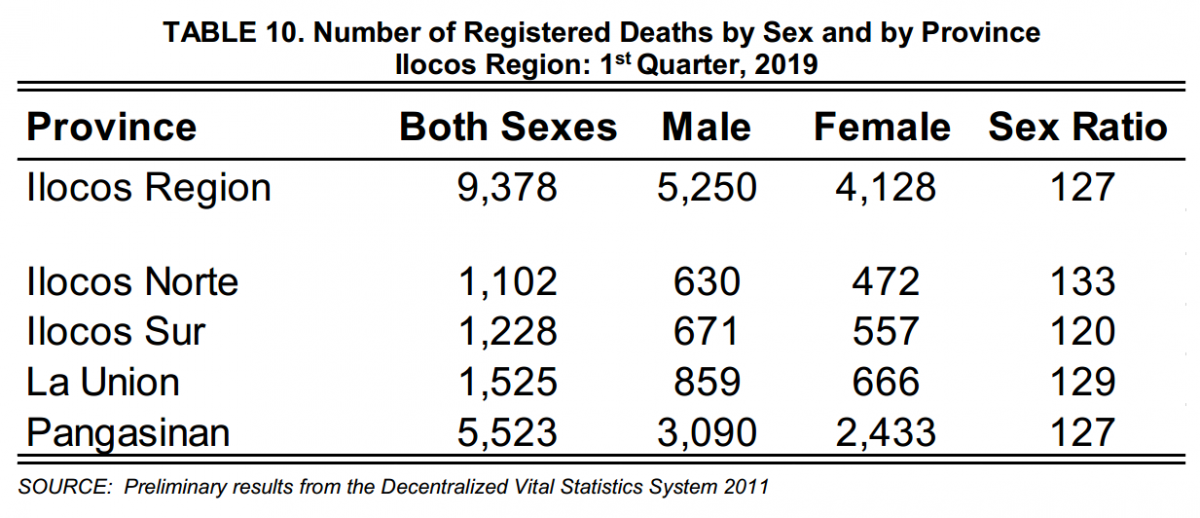
There were more death occurrences among males (5,250) than females (4,128) in Ilocos Region during the first quarter of 2019. The computed sex ratio during the quarter was 127 male deaths for every 100 female deaths.
Ilocos Norte posted the highest sex ratio with 133, La Union ranked second with 129 and followed by Pangasinan with 127. The lowest computed sex ratio of 120 male deaths per 100 female deaths was noted in Ilocos Sur.
Explanatory Notes
Introduction
Vital statistics are derived from information obtained at the time when the occurrences of vital events and their characteristics are inscribed in a civil register.
Vital acts and events are the births, deaths, fetal deaths, marriages, and all such events that have something to do with an individual’s entrance and departure from life together with the changes in civil status that may occur to a person during his lifetime. Recording of these events in the civil register is known as a vital or civil registration and the resulting documents are called vital records.
The structure of vital statistics system
The production of vital statistics comprised of the system of operation in which the registration of vital events is an important component. The system begins with the registration followed by processing and controlling of vital records and ends with the compilation and analysis of vital statistics.
Under commonwealth Act 591, the Bureau of Census (now PSA) is mandated to generate general purpose statistics and to carry out administer Act No. 3753.
Under the same law, the head of the NSO (now part of PSA) is also the Civil Registrar General (CRG) who directs and supervises the local civil registration activities in the country. The CRG in this regard is empowered to issue implementing rules and regulation on civil registration for proper compliance and, to design and order the printing of the necessary forms.
The vital statistics system involves different entities and cutting across different departments and personalities.
For the registration of vital events, the Local Civil Registry Offices (LCROs), which are the registration units in the country and headed by the City/Municipal Civil Registrars (C/MCRs), are under the Local Government Units (LGUs). The hospitals, clinics, rural health units and similar institutions including barangay secretaries, practicing physicians, midwives, nurses, traditional midwives, solemnizing officers from various religious sects and denomination are required to assists in the reporting of vital events for registration at the LCROs. The concerned parents, next of kin, contracting parties, witness or the person who has full knowledge of the occurrence of the events are also required to report the event, in default of the first mentioned set of informants.
The processing and controlling of vital documents are done at the LCROs and at the PSA Provincial and Central Offices.
The compilation and analysis of vital statistics is taken cared of by PSA central offices under the Vital Statistics Division (VSD) of the Civil Registration Service Office.
The Registration Method
As mandated in Act 3753, all vital events that marked the entry and departure of a person of his lifetime and the changes in his/her civil status shall be registered. The registration method is defined as continuous, permanent and compulsory recording of the occurrences and characteristics of vital events, primarily for their value as legal documents and secondary for their usefulness as a source of statistics.
Where to register the event
As a general rule, vital events should be registered at the LCRO where the events occur. In special cases, where the document about a vital event is presented to the LCRO which is not the place of occurrence, the same maybe accepted and is considered as out-of-town reporting. However, such documents should not be registered by the receiving LCRO. It must be forwarded to the LCRO where the event took place for purpose of registration.
Definition of terms and Concepts
This section presents the significant terminologist and descriptions in the foregoing highlights and tables are defined below. Included are some items found in the certificates and summary measure used in the certificates and summary used in the describing the facts of events.
Vital statistics on the other hand, are derived from information obtained at the time when the occurrences of vital events and their characteristics are inscribed in a civil register.
Live Birth is a complete expulsion or extraction from its mother of a product of conception, irrespective of the duration of the pregnancy, which after such separation, breathes or shows any other evidence of life, such as beating of the heart, pulsation of the umbilical cord, or definite movement of the voluntary muscles, whether or not the umbilical cord has been cut or the placenta is attached: each product of such a birth is considered live born.
Marriage is a special contract of permanent union between a man and a woman entered into in accordance with law for the establishment of conjugal and family life. It is the foundation of the family, a social institution that is governed by law and not subject to stipulation.
Death is a permanent disappearance of evidence of life. A fetus with intrauterine life of seven months or more and born alive at the time it was completely delivered from the maternal womb but died later shall be considered as death and shall be registered.

